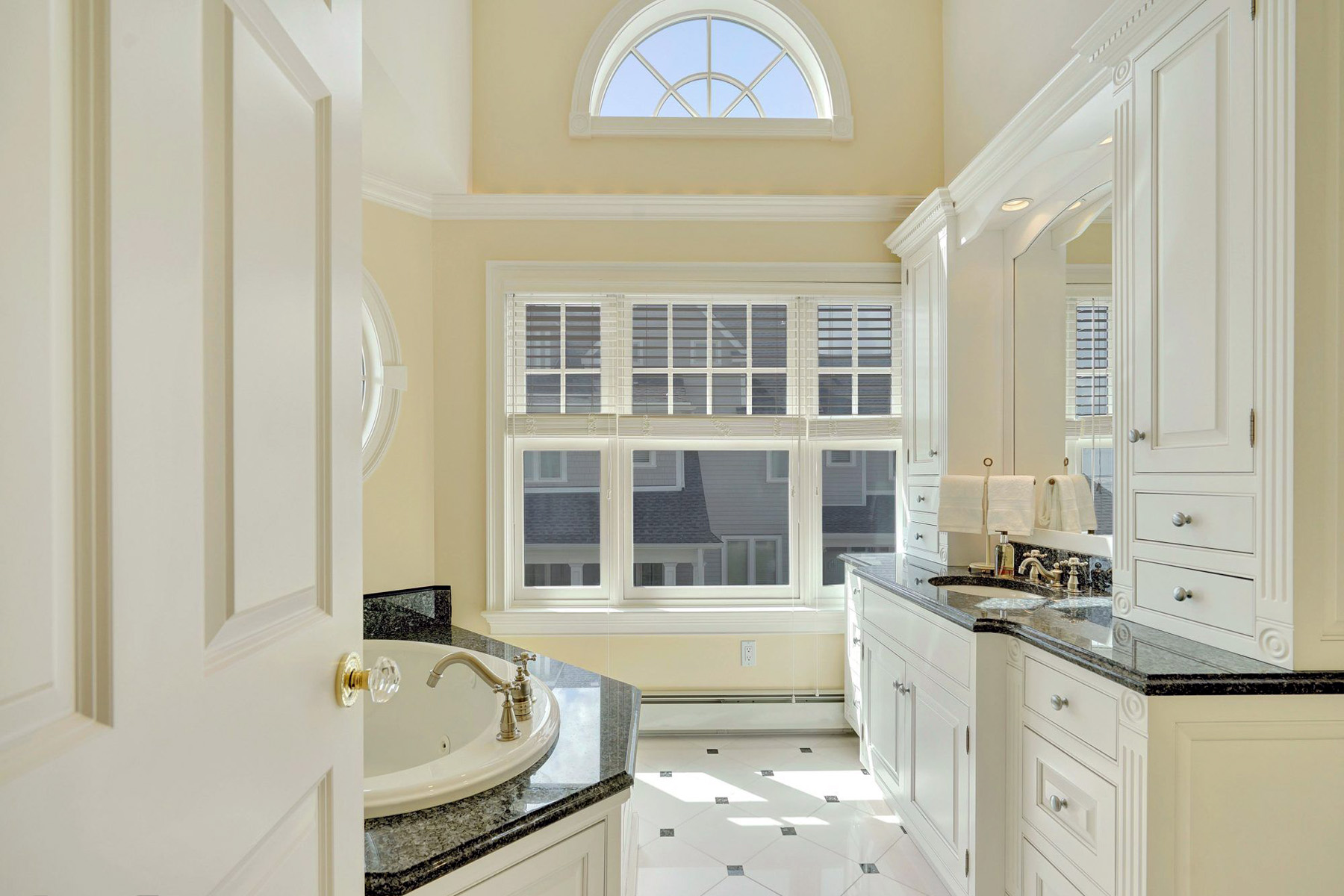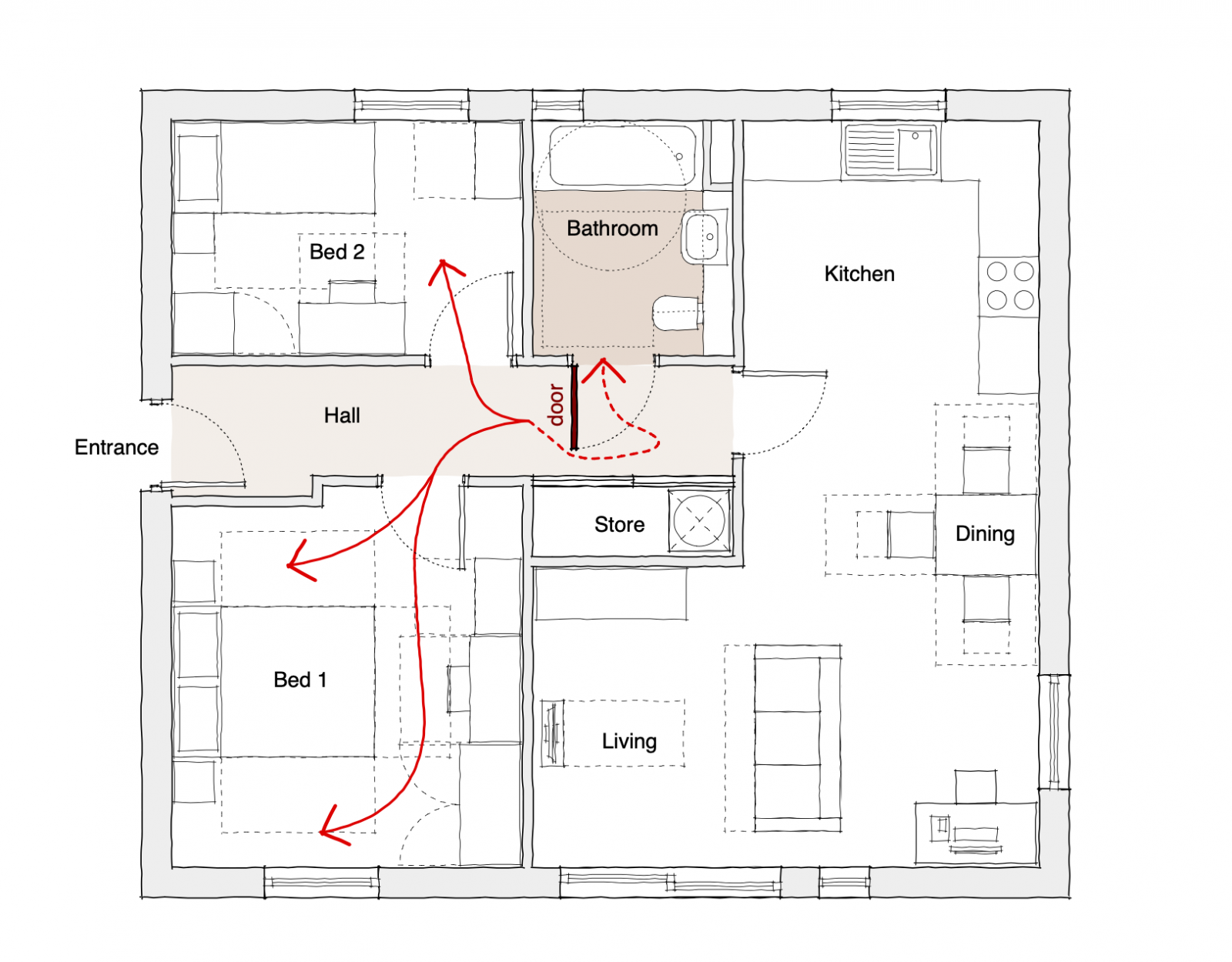Bathroom Door Swing Direction

Navigating the world of bathroom door swing direction might seem like a minor detail, but it’s a decision that can significantly impact the functionality and aesthetics of your bathroom. While it might seem like a straightforward choice, there are actually several factors to consider, from cultural norms to practical considerations.
Common Practices and Considerations
The typical swing direction for bathroom doors varies across different regions and cultures. In many Western countries, bathroom doors typically swing inward, while in some Asian countries, outward swinging doors are more common. This difference can be attributed to factors such as space constraints, cultural preferences, and building codes.
Advantages and Disadvantages of Inward and Outward Swinging Doors
- Inward Swinging Doors:
- Advantages:
- Provides privacy by preventing the door from opening into the hallway or adjacent space.
- Offers greater security as the door can be easily secured with a deadbolt.
- Can be more space-efficient in smaller bathrooms, as the door does not protrude into the hallway.
- Disadvantages:
- Can obstruct access to the bathroom if the space is narrow or if there is furniture or fixtures close to the door.
- May pose a safety hazard if the door swings into a hallway or walkway with high traffic.
- Can be difficult to open if the bathroom floor is wet or slippery.
- Advantages:
- Outward Swinging Doors:
- Advantages:
- Provides greater accessibility, especially for people with mobility limitations or using wheelchairs.
- Can create a more spacious feel in the bathroom by maximizing the usable floor space.
- Can be safer in emergencies, as the door swings away from the bathroom, allowing for easier escape.
- Disadvantages:
- Can obstruct hallway traffic or access to adjacent spaces.
- May not be as secure as inward swinging doors, especially if the door does not have a deadbolt.
- Can be less private, as the door can be easily seen from the hallway or adjacent space.
- Advantages:
Choosing the Appropriate Door Swing Direction
Choosing the appropriate door swing direction depends on a variety of factors, including:
- Space Constraints: In smaller bathrooms, inward swinging doors might be more space-efficient, while outward swinging doors might be better suited for larger bathrooms.
- Accessibility: For people with mobility limitations or using wheelchairs, outward swinging doors provide greater accessibility.
- Safety: In areas with high traffic or limited space, inward swinging doors can pose a safety hazard. Outward swinging doors are generally safer in emergencies, as they swing away from the bathroom, allowing for easier escape.
- Privacy: Inward swinging doors offer greater privacy, as they prevent the door from opening into the hallway or adjacent space.
- Aesthetics: The swing direction can also affect the overall aesthetic of the bathroom. In some cases, outward swinging doors can create a more modern or contemporary look.
Inward vs. Outward Swinging Doors: A Comparison
The following table provides a detailed comparison of the pros and cons of inward and outward swinging doors for various bathroom scenarios:
| Scenario | Inward Swinging Door | Outward Swinging Door |
|---|---|---|
| Small Bathroom | More space-efficient, but can obstruct access | Provides more usable floor space, but may obstruct hallway |
| Large Bathroom | May not be as necessary, but can still provide privacy | Offers greater accessibility and safety |
| High Traffic Area | Can be a safety hazard | Safer and more accessible |
| Limited Space | Can obstruct access and be difficult to open | Provides more space and easier access |
| Accessibility Needs | May be difficult for people with mobility limitations | Provides greater accessibility |
| Privacy Concerns | Offers greater privacy | May be less private |
| Security | More secure with a deadbolt | May be less secure without a deadbolt |
Factors Influencing Bathroom Door Swing Direction

The direction in which a bathroom door swings is not just an aesthetic choice. It has a significant impact on the functionality and usability of the space, particularly when considering factors like plumbing fixtures, layout, accessibility regulations, and traffic flow. Choosing the optimal swing direction requires careful consideration of these factors to create a bathroom that is both efficient and comfortable.
Impact of Plumbing Fixtures and Bathroom Layout
The placement of plumbing fixtures, such as the toilet, sink, and shower, plays a crucial role in determining the best door swing direction. The door should ideally swing open without obstructing any fixtures or creating a tight squeeze.
- For example, if the toilet is positioned directly opposite the door, a swing-out door could make it difficult to access the toilet. In this scenario, a swing-in door would be more suitable.
- Similarly, a swing-out door might be problematic if the sink is positioned close to the door, as it could impede access to the sink.
- The layout of the bathroom, including the size and shape of the room, also influences door swing direction. A small bathroom might benefit from a swing-in door to maximize usable space. Conversely, a larger bathroom might accommodate a swing-out door without compromising space.
Influence of Door Swing on Functionality and Traffic Flow
The swing direction of a bathroom door can significantly affect the functionality and flow of traffic within the space.
- A swing-out door might create a bottleneck if the bathroom is frequently used by multiple people, especially in a busy household.
- On the other hand, a swing-in door might limit access to the bathroom if the space is narrow or if there is furniture or other obstructions near the door.
- It is crucial to consider the intended use of the bathroom and the frequency of use when determining the optimal swing direction.
Role of Accessibility Regulations and Standards
Accessibility regulations and standards are essential considerations when determining bathroom door swing direction.
- The Americans with Disabilities Act (ADA) requires that doors in accessible bathrooms swing outward to allow for easy access and egress for people with disabilities.
- This regulation ensures that individuals using wheelchairs or other mobility aids can easily enter and exit the bathroom without encountering obstacles.
- Compliance with these standards is crucial for creating inclusive and accessible bathroom spaces.
Key Considerations for Optimal Door Swing Direction
Selecting the optimal door swing direction for a bathroom involves considering a combination of factors:
- Plumbing Fixture Placement: Ensure the door swing does not obstruct any fixtures.
- Bathroom Layout: Consider the size and shape of the bathroom to avoid overcrowding.
- Traffic Flow: Evaluate how the door swing might impact the movement of people in and out of the bathroom.
- Accessibility Regulations: Comply with accessibility standards for inclusive design.
- Personal Preference: While other factors are important, ultimately, the homeowner’s preference should also be considered.
Design Considerations and Solutions

Bathroom door swing direction – Choosing the right door swing direction is crucial for bathroom design, but it’s not always a straightforward decision. Space limitations, functionality, and aesthetics all play a role. Thankfully, innovative door solutions and creative design approaches can help overcome these challenges and create a bathroom that is both functional and stylish.
Alternative Door Swing Solutions
When traditional hinged doors pose a problem, alternative solutions offer a unique way to maximize space and enhance bathroom design. These solutions not only save valuable space but also add a touch of modern elegance to your bathroom.
- Pocket Doors: These doors slide seamlessly into a wall cavity, disappearing entirely when opened. They are ideal for small bathrooms where every inch counts, as they eliminate the need for swing space.
- Sliding Doors: Similar to pocket doors, sliding doors move along a track, typically mounted to the wall. They are often found in contemporary bathroom designs, adding a sleek and minimalist touch.
- Bi-Fold Doors: These doors consist of two or more panels that fold in half, allowing them to open and close compactly. They are a practical choice for small spaces, offering a space-saving alternative to traditional hinged doors.
Creative Design Approaches
Space limitations often present challenges in bathroom design. However, creative solutions can transform these limitations into opportunities to enhance functionality and aesthetics. By carefully considering door swing direction and incorporating clever design elements, you can create a bathroom that feels spacious and inviting.
- Utilizing Wall Space: When space is limited, utilizing wall space effectively becomes crucial. Installing a pocket door or sliding door can free up valuable floor space, allowing for more efficient use of the room.
- Creating a Visual Flow: The direction of a door swing can influence the visual flow of a bathroom. By strategically placing doors, you can create a sense of openness and spaciousness. For example, a door swinging inwards can create a sense of privacy and enclosure, while a door swinging outwards can create a sense of openness and accessibility.
- Incorporating Mirrors: Mirrors are a powerful tool for creating the illusion of space. By strategically placing mirrors, you can reflect light and make a bathroom appear larger. For instance, placing a mirror opposite a door can visually extend the space and create a sense of depth.
Incorporating Door Swing Direction into Design Aesthetics, Bathroom door swing direction
The direction of a bathroom door swing is not merely a practical consideration; it can also contribute to the overall design aesthetic. By harmonizing door swing direction with the style and layout of the bathroom, you can create a cohesive and visually pleasing space.
- Traditional Bathrooms: In traditional bathrooms, hinged doors with a classic design are often preferred. The swing direction can be chosen to complement the existing architecture, such as matching the swing of other doors in the house.
- Modern Bathrooms: Modern bathrooms often embrace minimalist designs and sleek lines. Pocket doors or sliding doors are popular choices in these settings, as they contribute to the streamlined aesthetic. The direction of the door swing can be chosen to maximize space and create a sense of openness.
- Contemporary Bathrooms: Contemporary bathrooms often feature bold and eclectic designs. Bi-fold doors or doors with unique hardware can add a touch of personality and individuality to the space. The swing direction can be chosen to create a focal point or enhance the overall design scheme.
Visual Representation of Bathroom Layouts
Imagine a small bathroom with limited space. A traditional hinged door swinging inwards would create a cramped and congested feeling. However, by incorporating a pocket door, the space immediately feels larger and more accessible. The pocket door disappears into the wall, maximizing floor space and creating a sense of openness.
Now, consider a spacious bathroom with a large walk-in shower. A sliding door on the shower enclosure would create a sleek and modern aesthetic. The sliding door moves along a track, minimizing swing space and maximizing the usable area of the bathroom.
The direction your bathroom door swings can impact the overall flow of your space. If you’re looking for a unique and stylish solution, consider a barn door! For guidance on how to create this eye-catching addition to your bathroom, check out how to make a barn door for bathroom.
Once you’ve installed your barn door, you can enjoy its sleek design and decide whether it should slide open to the left or right for optimal bathroom access.
Choosing the correct swing direction for your bathroom door is essential for maximizing space and creating a comfortable flow. While the swing direction is often dictated by the layout of your bathroom, it’s also important to consider the standard bathroom door size, which you can learn more about here.
Knowing the standard size will help you determine if a door with a specific swing direction will work well in your bathroom.